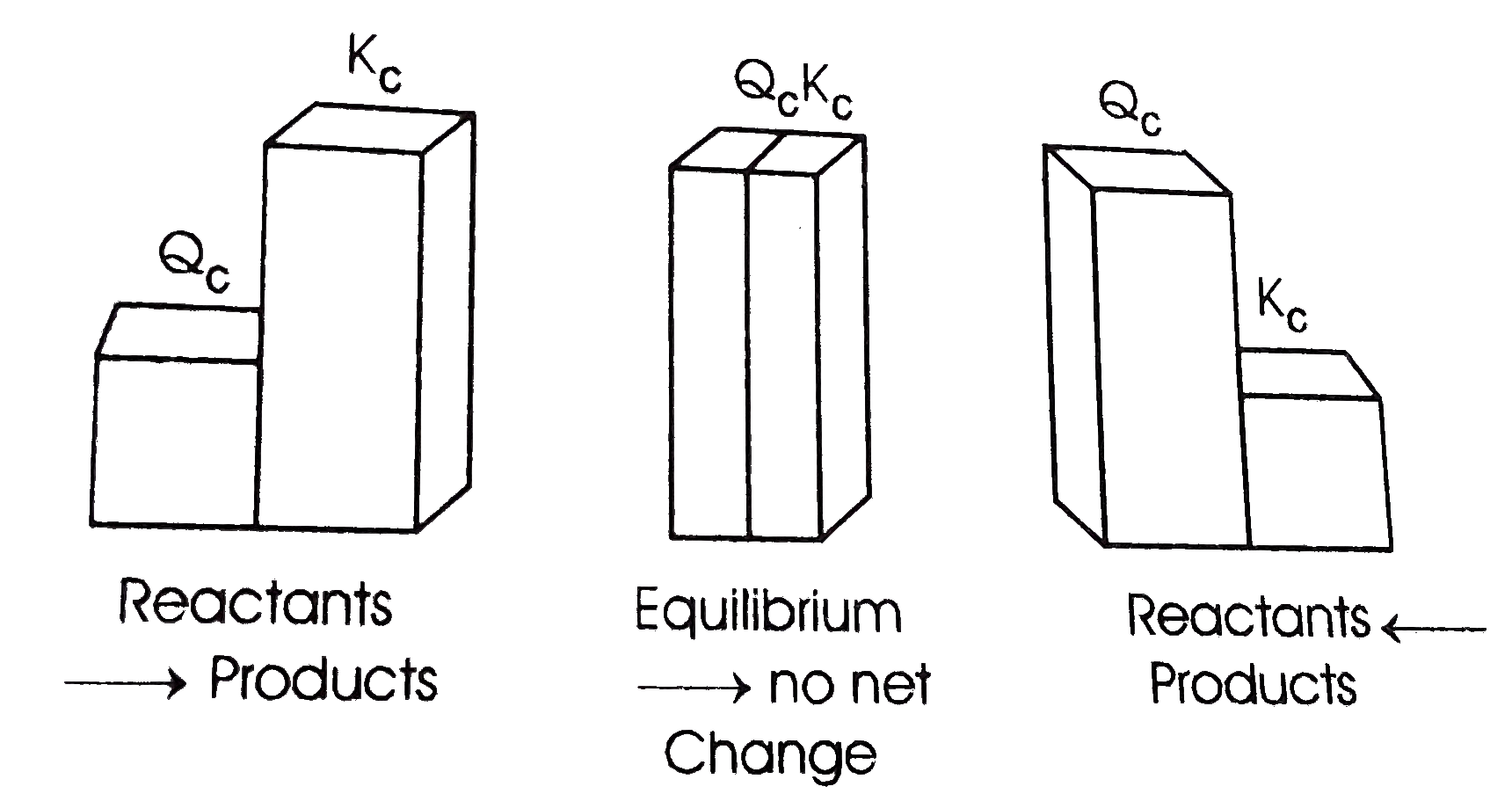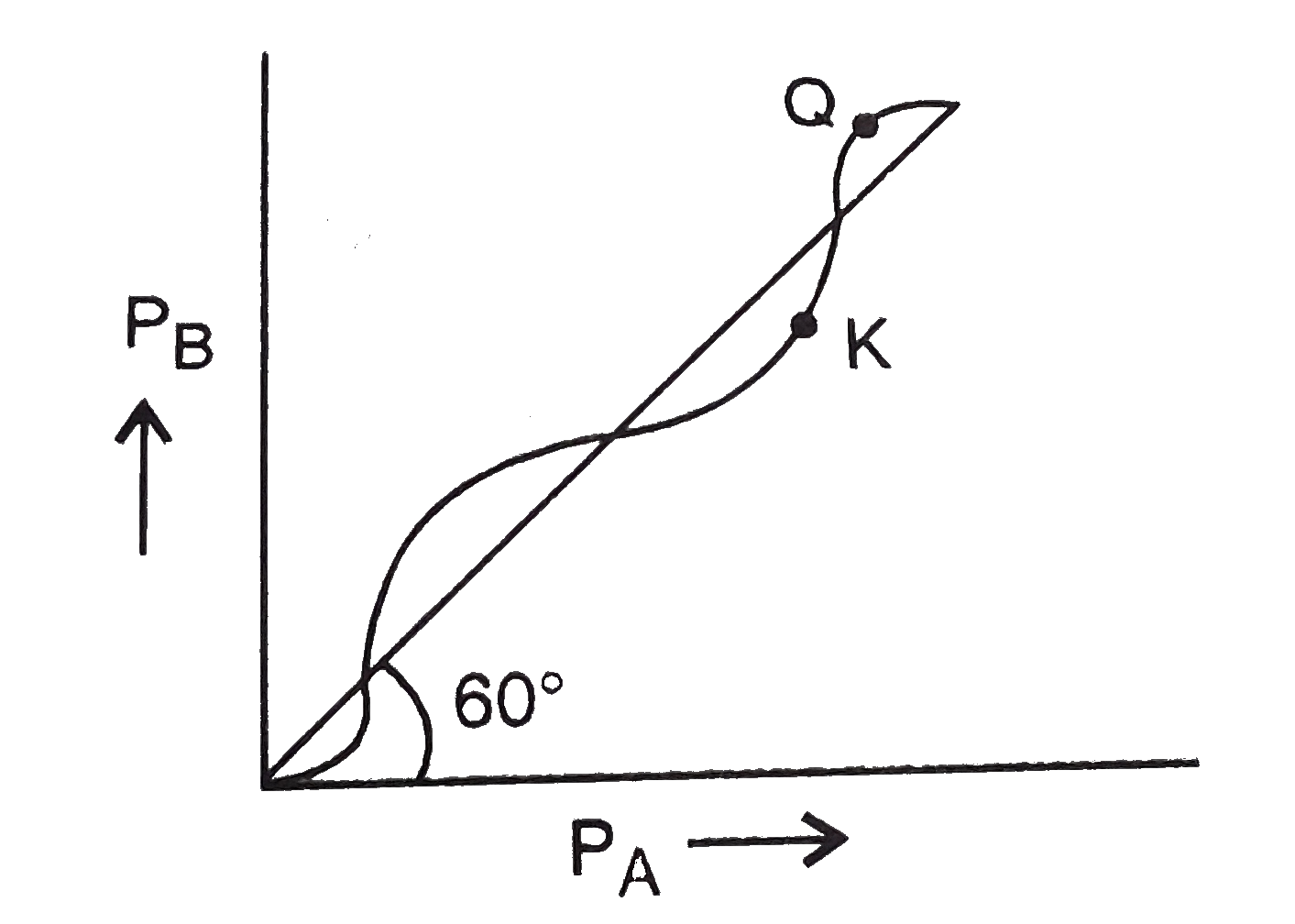ΔG∘ of reversible reaction at its equilbrium is
Positive
Negative
Always zero
May be(1) or (2)
The correct Answer is:D
To determine the value of ΔG° (Gibbs free energy change) for a reversible reaction at equilibrium, we can follow these steps:
Step 1: Understand the concept of Gibbs Free Energy (ΔG)
Gibbs free energy (G) is a thermodynamic potential that measures the maximum reversible work that can be performed by a thermodynamic system at constant temperature and pressure. The change in Gibbs free energy (ΔG) during a reaction indicates whether the reaction is spontaneous or not.
Step 2: Define equilibrium in a chemical reaction
At equilibrium, the rates of the forward and reverse reactions are equal, and the concentrations of reactants and products remain constant over time. This state indicates that the system is in a balanced condition.
Step 3: Relate ΔG to equilibrium
The change in Gibbs free energy (ΔG) can be expressed in terms of the standard Gibbs free energy change (ΔG°) and the reaction quotient (Q):
ΔG=ΔG°+RTlnQ
Where:
- R is the universal gas constant,
- T is the temperature in Kelvin,
- Q is the reaction quotient at any point in the reaction.
Step 4: Analyze the condition at equilibrium
At equilibrium, the reaction quotient (Q) becomes equal to the equilibrium constant (K). Therefore, we can rewrite the equation as:
ΔGeq=ΔG°+RTlnK
At equilibrium, the change in Gibbs free energy (ΔG) is zero:
0=ΔG°+RTlnK
Step 5: Solve for ΔG°
Rearranging the equation gives us:
ΔG°=−RTlnK
This indicates that at equilibrium, the standard Gibbs free energy change (ΔG°) is related to the equilibrium constant (K) of the reaction.
Conclusion
At equilibrium, the value of ΔG° for a reversible reaction is zero:
ΔG°=0
Final Answer
The value of ΔG° of a reversible reaction at its equilibrium is 0.
---
Gibbs free energy (G) is a thermodynamic potential that measures the maximum reversible work that can be performed by a thermodynamic system at constant temperature and pressure. The change in Gibbs free energy (ΔG) during a reaction indicates whether the reaction is spontaneous or not.
At equilibrium, the rates of the forward and reverse reactions are equal, and the concentrations of reactants and products remain constant over time. This state indicates that the system is in a balanced condition.
The change in Gibbs free energy (ΔG) can be expressed in terms of the standard Gibbs free energy change (ΔG°) and the reaction quotient (Q):
ΔG=ΔG°+RTlnQ
Where:
- R is the universal gas constant,
- T is the temperature in Kelvin,
- Q is the reaction quotient at any point in the reaction.
At equilibrium, the reaction quotient (Q) becomes equal to the equilibrium constant (K). Therefore, we can rewrite the equation as:
ΔGeq=ΔG°+RTlnK
At equilibrium, the change in Gibbs free energy (ΔG) is zero:
0=ΔG°+RTlnK
Rearranging the equation gives us:
ΔG°=−RTlnK
This indicates that at equilibrium, the standard Gibbs free energy change (ΔG°) is related to the equilibrium constant (K) of the reaction.
At equilibrium, the value of ΔG° for a reversible reaction is zero:
ΔG°=0
The value of ΔG° of a reversible reaction at its equilibrium is 0.
Topper's Solved these Questions
- THERMODYNAMICSBOOK - AAKASH INSTITUTECHAPTER - THERMODYNAMICSEXERCISE - ASSIGNMENT (Section - A) Objective Type Questions
55 Videos
- THERMODYNAMICSBOOK - AAKASH INSTITUTECHAPTER - THERMODYNAMICSEXERCISE - ASSIGNMENT (Section - B) Objective Type Questions
35 Videos
- THERMODYNAMICSBOOK - AAKASH INSTITUTECHAPTER - THERMODYNAMICSEXERCISE - SECTION-J
7 Videos
- THE SOLID STATE BOOK - AAKASH INSTITUTECHAPTER - THE SOLID STATE EXERCISE - Assignment (SECTION - D) (ASSERTION-REASON TYPE QUESTION)
20 Videos
Similar Questions
Standard free energy change(ΔG∘) of a reaction is related to its equilibrium constant as :K=10x where x=….................
View SolutionFor the following equilibrium, Kc=6.3×1014at1000K
NO(g)+O3(g)⇔NO2(g)+O2(g)
Both the forward and reverse reactions in the equilibrium are elementary bimolecular reactions. What is Kc, for the reverse reaction?
View Solution
Knowledge Check
In reversible reactions
Aconcentration of reactants decreases with timeBconcentration of products increases with timeCconcentration of reactants decreases and then increases with timeDconcentration of reactants and products are constant at equilibriumIf ΔG∘>0 for a reaction then :
AKP>1BKP<1CThe products predominate in the equilibrium mixtureDNoneThe reaction which is in dynamic equilibrium, ensured us, that the reaction is reversible . But if that the reaction is in equilibrium. The reaction quotient predict either the reversible reaction is in equilibrium or tries to achieve equilibrium. In those reactions which have not achieved equilibrium, we obtain reaction quotient Qc in place of equilibrium constant (Kc) by substituting the concentration of reactant and product at the time, at whih we have to calculate the value of Qc . To determine the direction at which the net reaction will proceed to achieve equilibrium, we compare values of Qc and Kc. The three possible cases are shown as comparison of Kc and Qc in the following figures.

Change in Gibbs free energy, i.e., ΔG is the driving force of any reaction.
For spontaneous reaction , ΔG=−ve
For non-spontaneous reaction , ΔG=+ve
For reaction at equilibrium , ΔG=0
Thermodynamically, we know that
ΔG=ΔG∘+RTlnQ, where Q is reaction quotient and ΔG∘= change in Gibbs energy at standard condition.
For equilibrium A(g)⇔B(g)(Keq=1.732) If the pressure of the system [varied by introducing a stream of A(g) and B (g) is represented by the curve at constant temperature T.

Which of the following is the correct statement at point R in the figure above ?AThe reaction will move in backward direction in order to gain equilibriumBThe reaction will move in forward direction in order to gain equilibriumCΔG of the reaction will be zeroDCannotbe predicted.
For the following equilibrium, Kc=6.3×1014at1000K
NO(g)+O3(g)⇔NO2(g)+O2(g)
Both the forward and reverse reactions in the equilibrium are elementary bimolecular reactions. What is Kc, for the reverse reaction?
View SolutionIn a reversible reaction, the forward reaction was 3 times faster than that of reverse reaction. The reaction quotient is.....
View SolutionThe reaction which is in dynamic equilibrium, ensured us, that the reaction is reversible . But if that the reaction is in equilibrium. The reaction quotient predict either the reversible reaction is in equilibrium or tries to achieve equilibrium. In those reactions which have not achieved equilibrium, we obtain reaction quotient Qc in place of equilibrium constant (Kc) by substituting the concentration of reactant and product at the time, at whih we have to calculate the value of Qc . To determine the direction at which the net reaction will proceed to achieve equilibrium, we compare values of Qc and Kc. The three possible cases are shown as comparison of Kc and Qc in the following figures.

Change in Gibbs free energy, i.e., ΔG is the driving force of any reaction.
For spontaneous reaction , ΔG=−ve
For non-spontaneous reaction , ΔG=+ve
For reaction at equilibrium , ΔG=0
Thermodynamically, we know that
ΔG=ΔG∘+RTlnQ, where Q is reaction quotient and ΔG∘= change in Gibbs energy at standard condition.
For equilibrium A(g)⇔B(g)(Keq=1.732) If the pressure of the system [varied by introducing a stream of A(g) and B (g) is represented by the curve at constant temperature T.

What will be the value of difference of standard Gibbs free energy to Gibbs free energy change at point Q in the figure above ?
View SolutionConsider the reaction
A(g)+B(g)⇔C(g)+D(g)
Which occurs in one step. The specific rate constant are 0.25 and 5000 for the forward and reverse reaction, respectively. The equilibrium constant is
View SolutionThe reaction which is in dynamic equilibrium, ensured us, that the reaction is reversible . But if that the reaction is in equilibrium. The reaction quotient predict either the reversible reaction is in equilibrium or tries to achieve equilibrium. In those reactions which have not achieved equilibrium, we obtain reaction quotient Qc in place of equilibrium constant (Kc) by substituting the concentration of reactant and product at the time, at whih we have to calculate the value of Qc . To determine the direction at which the net reaction will proceed to achieve equilibrium, we compare values of Qc and Kc. The three possible cases are shown as comparison of Kc and Qc in the following figures.

Change in Gibbs free energy, i.e., ΔG is the driving force of any reaction.
For spontaneous reaction , ΔG=−ve
For non-spontaneous reaction , ΔG=+ve
For reaction at equilibrium , ΔG=0
Thermodynamically, we know that
ΔG=ΔG∘+RTlnQ, where Q is reaction quotient and ΔG∘= change in Gibbs energy at standard condition.
For equilibrium A(g)⇔B(g)(Keq=1.732) If the pressure of the system [varied by introducing a stream of A(g) and B (g) is represented by the curve at constant temperature T.

Suppose the equilibrium system
N2O4(g)⇔2NO2(g)
N2O4(g) is in a cylinder fitted with a movable piston . Which of the following statements is correct ?
View Solution
